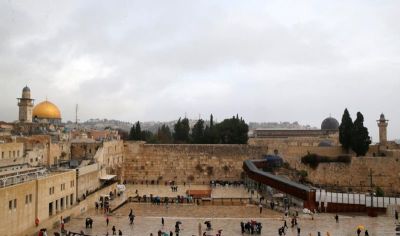Making a Modern Pilgrimage

Many of us think of prayer as something we do with heart and mind. We don't always consider what it means to pray with our bodies, but discipleship always involves our physical selves as well as our inner lives. A physical pilgrimage can reconnect our body to our soul. An acquaintance of mine, Fran, walked the Camino pilgrim route during thirty-six days in the summer of 2016. She told me, "The prayer of the body that a pilgrimage, any pilgrimage, offers is a real gift. Whether you are walking around the block or on the Way of St. James, it is a chance to truly be transformed." A year after she completed the Camino journey, she reports that her life has changed in ways both deep and permanent: "The pilgrimage changed everything for me. I find that I am called to a simpler life and that I worry less."
Some Christians making modern pilgrimages to sacred sites are seeking a place of encounter with God. In this desire to experience connection with the divine beyond themselves, they may share a distant kinship with some of those making secular pilgrimages. However, for the Christian, the experience of traveling in a sacrificial manner to a holy destination can serve to strengthen their faith and illumine the contours of the narrow road they're already walking. The ancient Celts called locations where the divine seemed especially near "thin places." Though God is present everywhere at all times, Scripture tells us there are specific sites God designated to meet with His people: with Moses at the burning bush in the desert, at Mt. Sinai as He gave Moses the Law, and most notably, at the tabernacle—particularly in the Holy of Holies—and then, after Israel inhabited the Promised Land, at the temple in Jerusalem.
While modern notions of thin places lean heavily toward places thick with the invitation to introspection and spiritual renewal, pastor Mark Roberts noted that in the Old Testament, the temple—the ultimate thin place—was anything but quiet: "The Temple was not . . . a place of worship like a synagogue or church sanctuary. Nor was it a quiet place for retreat, at least not in the courts where ordinary folk were welcome. The Temple, by its very design, kept people away from its holiest places, the places where God was said to dwell and where priests alone could enter. Yet common people surely experienced God's presence in the Temple courts, and in this sense those courts constituted a thin place."6
Under the new covenant, our bodies—our very selves—are the temple. His Spirit resides within us and with us. We aren't bound by law to make thrice-yearly pilgrimages to a specific place to worship. But the act of pilgrimage to a holy place can be a transformative experience for those who feel led to make such a journey.
I have been to Jerusalem seven times. It is the ultimate pilgrimage destination for the believer, filled with Bible history at every turn, and the opportunity to walk where Jesus walked. Of course, Christians don't have a corner on Jerusalem. Jews and Muslims lay claim to the city, too, and it serves as flashpoint of ages-old political tensions between the three faiths. In some ways, it is like any other urban area, full of the daily bedlam of people conducting business, raising families, and talking into their cellphones. (So many cellphones!) Every historic spot in the Old City is filled with tourists taking pictures to prove they were there. Yet, it is undeniable there is still an imprint of the presence of God in the place, mixed with the longing of the devout and the spiritual hunger of the curious who make the journey to the Holy City. Despite the long history of religious and political tensions, and the daily cacophony of modern life, many pilgrims continue to report thin place experiences there, sometimes when they're least expecting it.
The first time my husband and I arrived in Jerusalem, we'd flown through the night and had been awake more than twenty-four hours. When we arrived at our hotel, it was too early to check into our room, so we stowed our bags with the hotel clerk, ate something, and decided we'd go for a walk. We set out in the general direction of the Old City, but quickly realized the little plastic tourist map I was carrying would be of no use once we entered the Jaffa Gate. Those narrow, crowded ancient streets and twisting, shadowed alleyways were a baffling maze to both of us, particularly in our sleep-deprived state.
We had no specific destination in mind. Like many married couples, when Bill and I are lost, we tend to bicker a bit. Not that day. It was as though an unseen hand was guiding us to exactly where we needed to go. We just kept walking, not stopping to look or shop or take pictures. A turn, then another and another, down a steep hill as we dodged cabs and wove our way through crowds—and there it was: the Western Wall.
This span of ancient Jerusalem stone is an intact piece of the temple's presence on this spot until the holy place was destroyed by the Romans in AD 70. The Western Wall is a place of deep longing, collective sorrow, and the locus of generations of imprecations and praise from pilgrims. It is the physical link to the beauty of a temple once filled with the presence of God and the longing among the Jewish people for a Messiah to reign on the earth in perfect justice and pure mercy.
Bill and I weren't trying to find the wall. We had plans to visit a couple of days later. Our agenda didn't matter. When we stood in front of that holy and heartbreaking wall, the realization that we'd been drawn there like exhausted moths to a flame was life-altering for me. In that moment and place, my own ache for home—an ache that has marked the diaspora experience of my people—was simultaneously exposed and salved, my identity as a Jewish follower of Jesus was affirmed within me in a place too deep for words. My trust grew in the Holy Spirit's faithfulness in leading us exactly where we need to go, every step of our journey.
We were standing in a thin place.
Many of us have had these experiences even when we haven't traveled a step. These moments during a time of worship or prayer, during a period of great sorrow or trial can undo us with an overwhelming awareness of God's nearness, holiness, and love. Eternity invades time, and the membrane between heaven and earth seems thin as silk. It takes a pilgrim to breathe the atmosphere there.
Yet thin places are not a permanent destination. Jesus' disciples found themselves in a thin place when they experienced the transfiguration of Jesus and a visitation from Moses and Elijah (Matt. 17:1–13). Peter offered to build shelters for the visitors and his friend Jesus—perhaps to capture permanently the thin place experience. They discovered that the experience had little to do with staying put. It was, at least in part, meant to illumine their understanding of who Jesus was and nurture their obedience to Him as they continued their pilgrim journey with Him.
Taken from Born to Wander: Recovering the Value of Our Pilgrim Identity by Michelle Van Loon (©2018). Published by Moody Publishers. Used by permission.





















